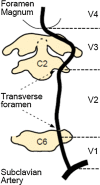Blunt traumatic vertebral artery injury: a clinical review
- PMID: 21674212
- PMCID: PMC3175894
- DOI: 10.1007/s00586-011-1862-y
Blunt traumatic vertebral artery injury: a clinical review
Abstract
Blunt traumatic vertebral injury (TVAI) is frequently associated with head and neck injury and is being detected with increasing frequency due to improved imaging of the trauma patient. In a few cases, it can lead to potentially fatal posterior circulation ischaemia There is debate in the literature regarding whether TVAI should be actively screened for and, if so, how. Management of TVAI may be conservative, medical (antiplatelet agents or anticoagulation), endovascular or open surgery. We review the literature concerning the mechanisms and presentation of TVAI following blunt injury and the current screening recommendations. Management strategies proposed are based on the radiological grade and clinical severity of TVAI, where high-grade symptomatic injuries and high-grade injuries in patients where anticoagulation is contraindicated are treated endovascularly and asymptomatic or low-grade injuries are managed with anticoagulation where it is not contraindicated. Follow-up is via CT angiography to assess for resolution of the injury.
Figures



References
-
- Cothren CC, Moore EE. Blunt cerebrovascular injuries. Clinics (Sao Paulo) 2005;60(6):489–496. - PubMed
Publication types
MeSH terms
Substances
LinkOut - more resources
Full Text Sources

